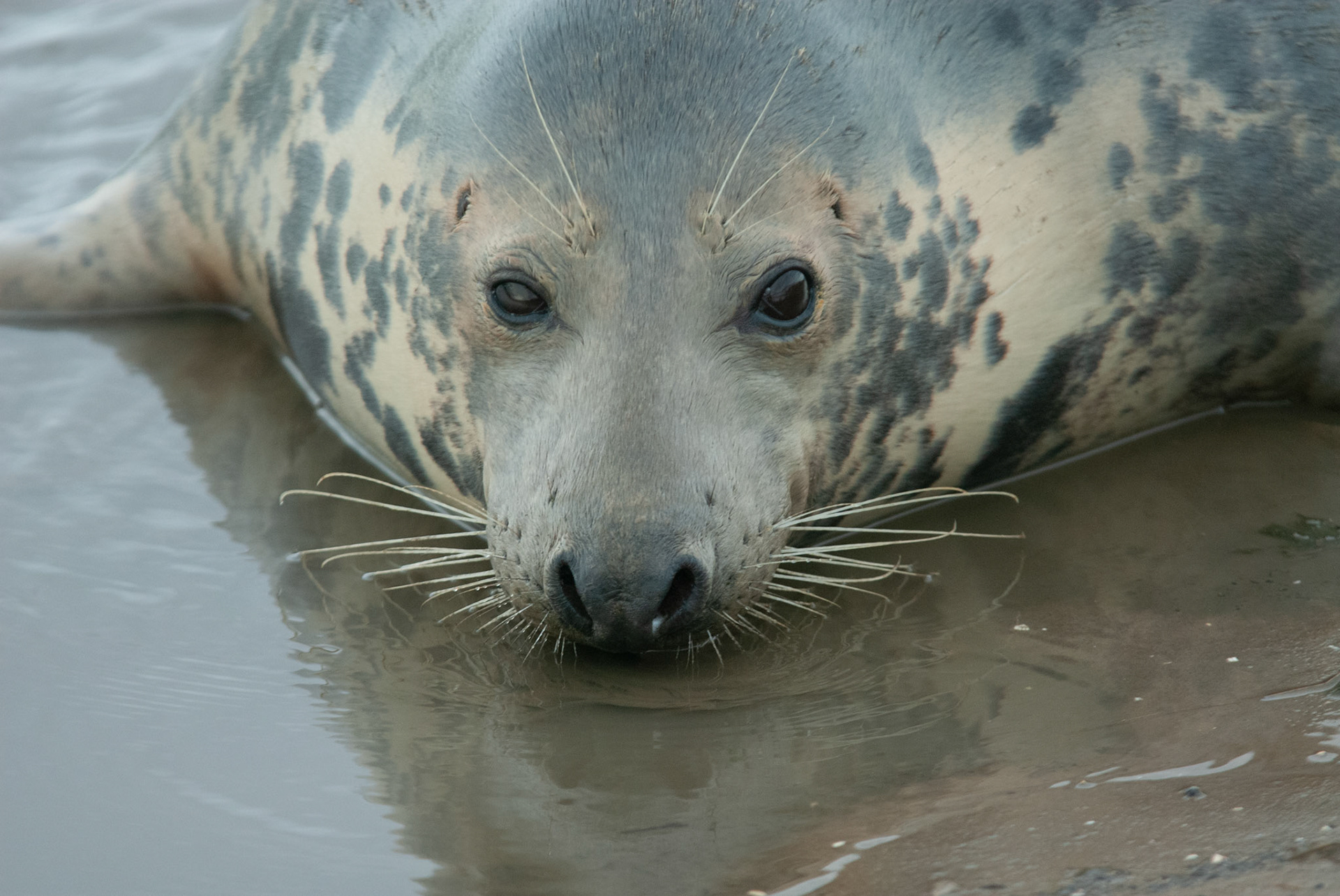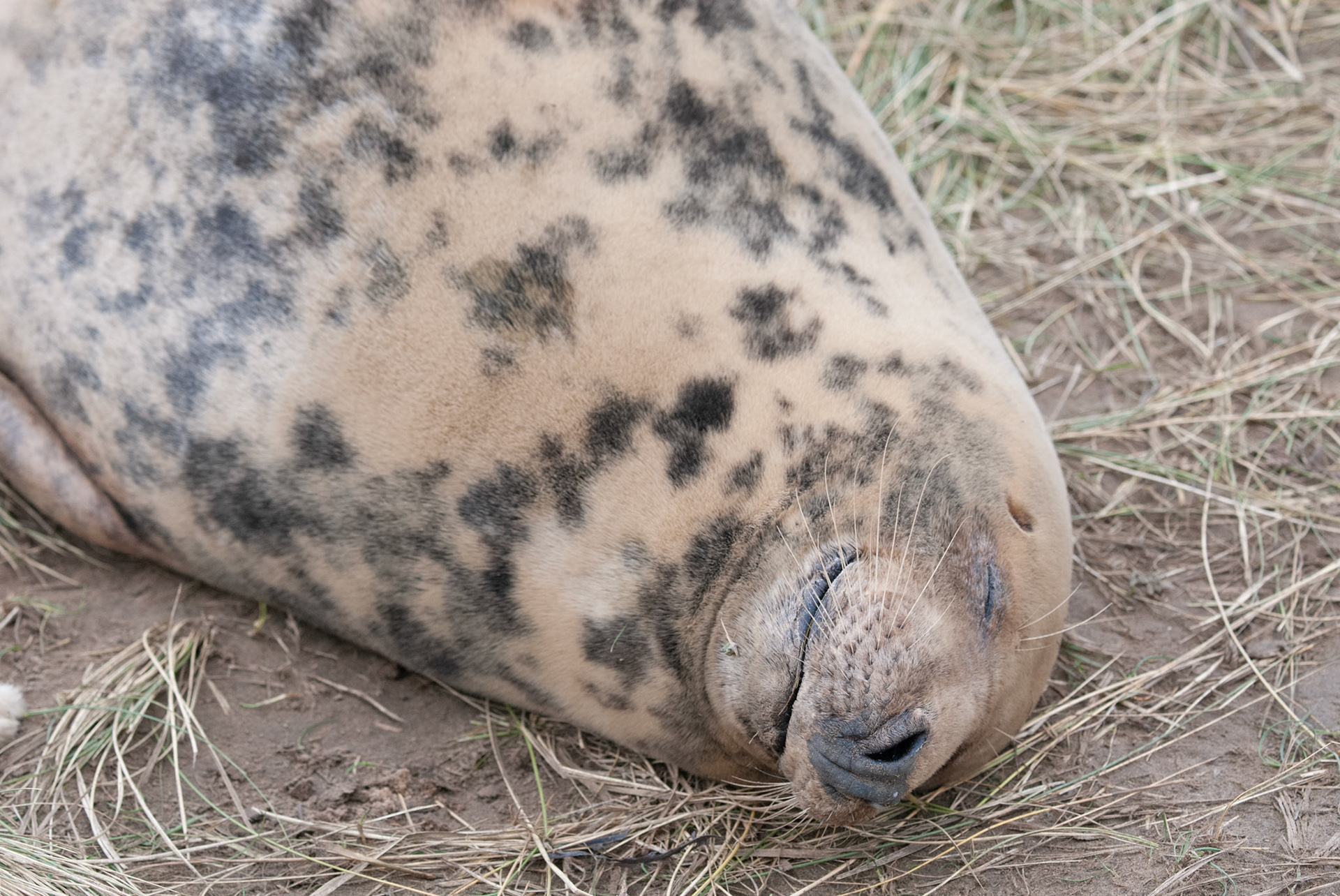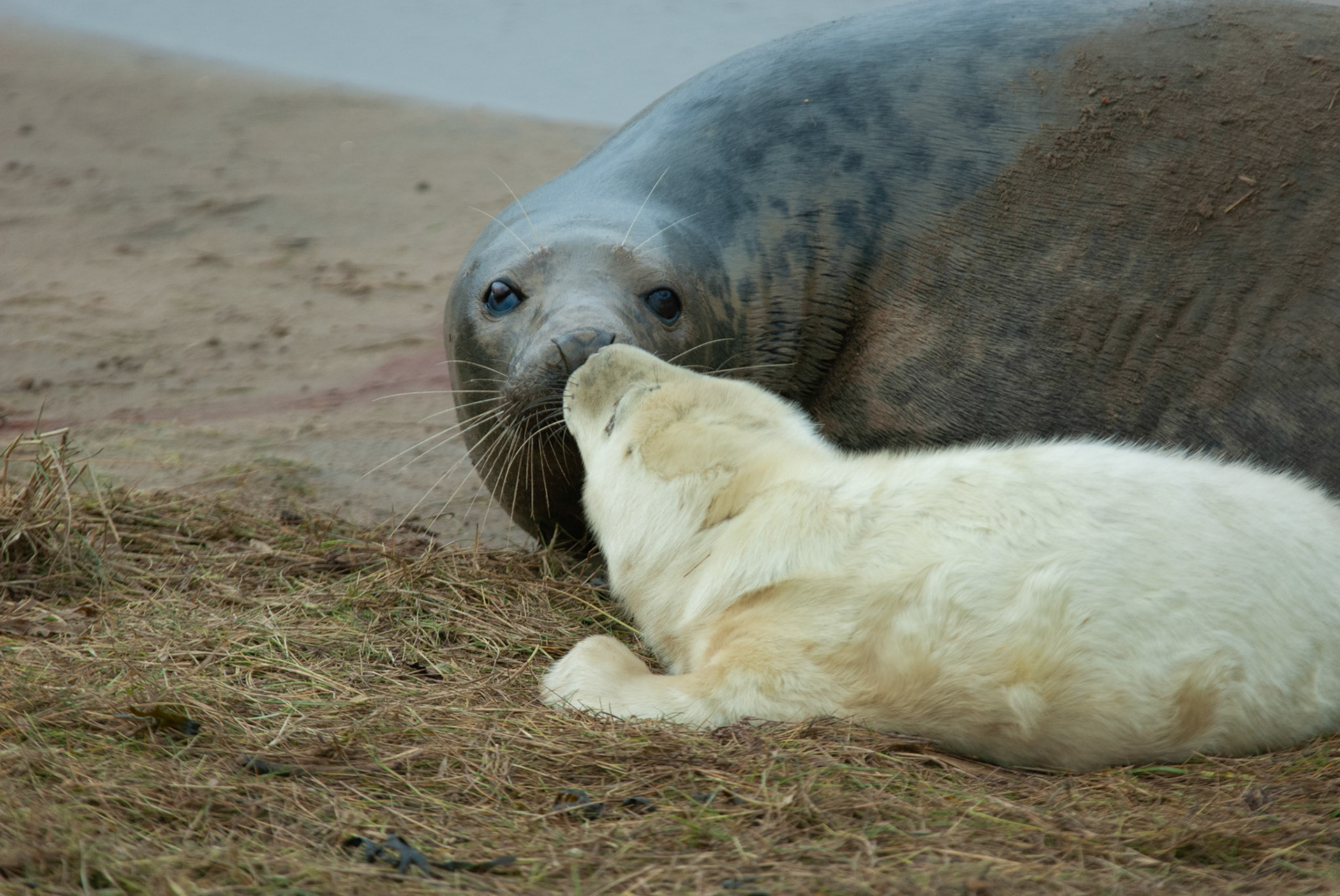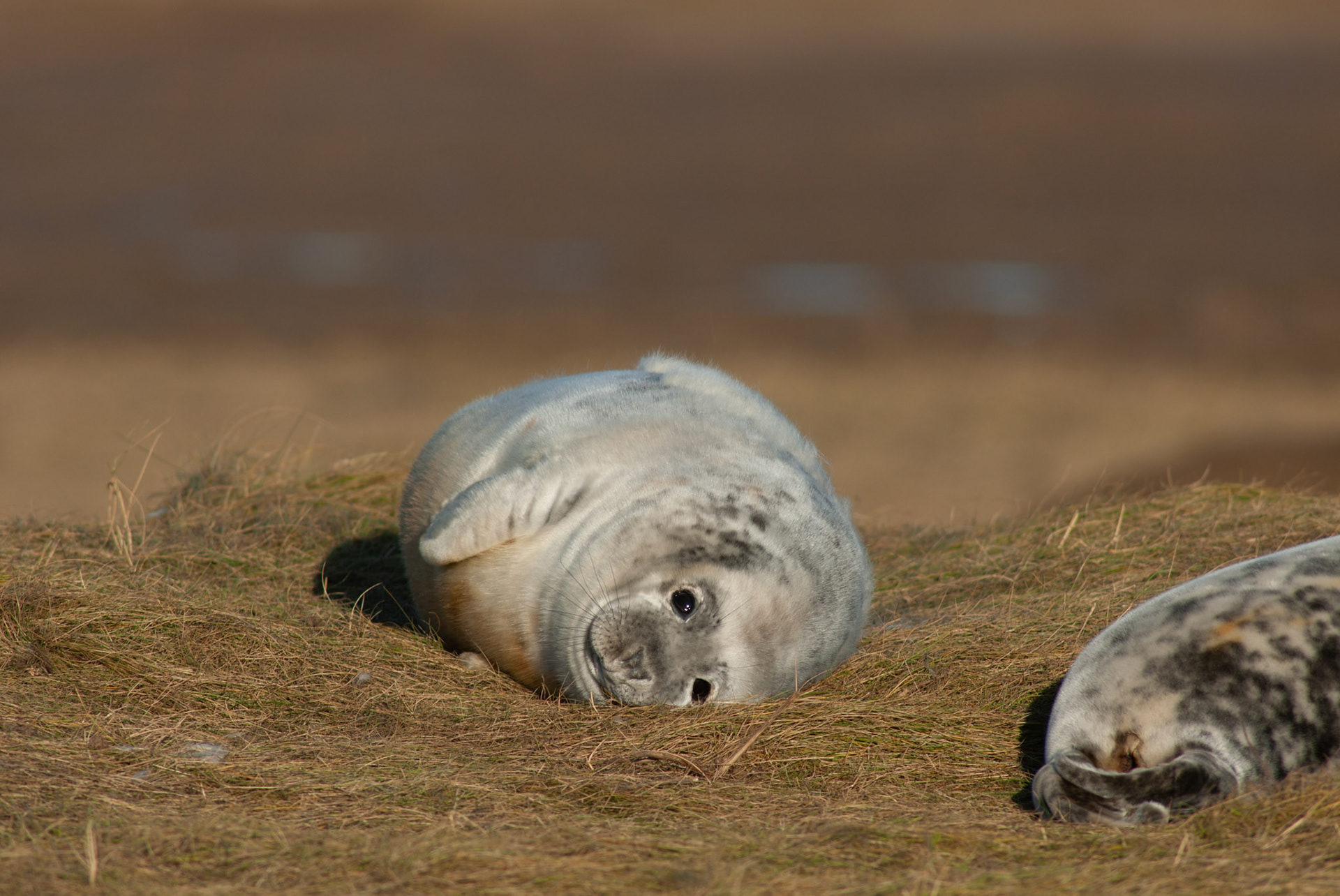By far Britain’s largest carnivorous mammal, the grey seal’s thick layer of insulating blubber means that it can survive in water cold enough to kill a human in minutes.
SIZES
Length: Males up to 3.3m. Females, 2.5m.
Weight: Males up to 315kg_ Females, 200kg.
BREEDING
Sexual maturity: Males 6-10 years. Females 5-6 years.
Mating: Between September and March, according to location
Gestation: 1 year. No. of young: 1 pup..
LIFESTYLE Habit: Solitary hunters, sociable on shore
Call: Deep wailing song.
Diet: Open sea and bottom dwelling fish and some invertebrates.
RELATED SPECIES
Other grey seals include: Hahchoerus grypus grypus, NW Atlantic and Halichoerus gbalhcus, Baltic Sea.
Length: Males up to 3.3m. Females, 2.5m.
Weight: Males up to 315kg_ Females, 200kg.
BREEDING
Sexual maturity: Males 6-10 years. Females 5-6 years.
Mating: Between September and March, according to location
Gestation: 1 year. No. of young: 1 pup..
LIFESTYLE Habit: Solitary hunters, sociable on shore
Call: Deep wailing song.
Diet: Open sea and bottom dwelling fish and some invertebrates.
RELATED SPECIES
Other grey seals include: Hahchoerus grypus grypus, NW Atlantic and Halichoerus gbalhcus, Baltic Sea.
With large appealing eyes and sleek coats, grey seals are a popular sight on remote British shorelines, their large roman noses distinguishing them from the common seal. Their streamlined shape and powerful fins make them expert swimmers.
FOOD & HUNTING
Seals vary their diet ac-cording to the fish available. Large eyes with flat corneas enable them to see well in murky waters, but hearing and taste are more important when hunting and even blind seals have no difficulty in catching prey. The seal has no external ears but has a sensitive internal hearing apparatus to aid tracking prey. This can be closed to exclude water when it dives. Probably an echo-location system, similar to the dolphin’s, is used when hunting. The mu-Me and whiskers are highly sensitive, picking up water movements made by escaping prey as the seal moves in for the kill. The large, highly sensitive wet nose (rhinarium) is used to ‘taste’ the water for changes in its chemical composition. Once prey is detected, the seal gives chase, catching fish by mobility and speed. Be-cause the sears blood contains high amounts of haemoglobin (the red substance that carries oxygen around the body) it can stay underwater for up to 20 minutes, although five to ten minutes is normal. When diving, the heart rate slows down to conserve oxygen.
Seals vary their diet ac-cording to the fish available. Large eyes with flat corneas enable them to see well in murky waters, but hearing and taste are more important when hunting and even blind seals have no difficulty in catching prey. The seal has no external ears but has a sensitive internal hearing apparatus to aid tracking prey. This can be closed to exclude water when it dives. Probably an echo-location system, similar to the dolphin’s, is used when hunting. The mu-Me and whiskers are highly sensitive, picking up water movements made by escaping prey as the seal moves in for the kill. The large, highly sensitive wet nose (rhinarium) is used to ‘taste’ the water for changes in its chemical composition. Once prey is detected, the seal gives chase, catching fish by mobility and speed. Be-cause the sears blood contains high amounts of haemoglobin (the red substance that carries oxygen around the body) it can stay underwater for up to 20 minutes, although five to ten minutes is normal. When diving, the heart rate slows down to conserve oxygen.
THE GREY SEAL’S HABITAT & SENSES
Grey seals like to haul-out on rocky islands to rest and dry out. A quiet cave with a front and a back door is ideal. During the breeding season the beaches are crowded with females giving birth and males trying to establish ferritories for mating.
Nose is used to taste water for prey
Eyes large for good vision but are not as vital as other features.
Whiskers can feel the slightest vibrations.
Grey seals like to haul-out on rocky islands to rest and dry out. A quiet cave with a front and a back door is ideal. During the breeding season the beaches are crowded with females giving birth and males trying to establish ferritories for mating.
Nose is used to taste water for prey
Eyes large for good vision but are not as vital as other features.
Whiskers can feel the slightest vibrations.
DISTRIBUTION
NE Atlantic (from Spitzbergen to South Iceland, Britain and Eire) also NW Atlantic and Baltic Sea.
NE Atlantic (from Spitzbergen to South Iceland, Britain and Eire) also NW Atlantic and Baltic Sea.
CONSERVATION
Total population estimated at 120,000 — 135,000. Largest colony of 80,000 found round British Isles. Protected by law. No culls allowed during the ‘seal virus’ crisis of 1988 although the main threat was to common seals. .
Total population estimated at 120,000 — 135,000. Largest colony of 80,000 found round British Isles. Protected by law. No culls allowed during the ‘seal virus’ crisis of 1988 although the main threat was to common seals. .
SEALS & MAN
Seals have been hunted by man for thousands of years. Their skins were used to pro-vide clothing, while their blubber was turned into oil for lamps. Many coastal communities ate seal meat as part of their staple diet. In more recent times, grey seal pups were killed to pro-vide white or cream furs for the fashion industry. Today, due to the efforts of conservationists, the fur is no longer valuable, as people have become aware of the plight of the seal pups and culling has almost completely stopped. Grey seals are not always popular, however. Fishermen claim that they consume large quantities of salmon and cod. Scientists disagree, and say that grey seals do not seriously reduce the numbers of these fish. In 1988 grey seals were affected, although to a lesser degree, by the same virus that seriously reduced the common seal population.
Seals have been hunted by man for thousands of years. Their skins were used to pro-vide clothing, while their blubber was turned into oil for lamps. Many coastal communities ate seal meat as part of their staple diet. In more recent times, grey seal pups were killed to pro-vide white or cream furs for the fashion industry. Today, due to the efforts of conservationists, the fur is no longer valuable, as people have become aware of the plight of the seal pups and culling has almost completely stopped. Grey seals are not always popular, however. Fishermen claim that they consume large quantities of salmon and cod. Scientists disagree, and say that grey seals do not seriously reduce the numbers of these fish. In 1988 grey seals were affected, although to a lesser degree, by the same virus that seriously reduced the common seal population.
DID YOU KNOW?
• The grey seal’s Latin name is derived from Greek and means `little pig from the sea’.
• Celtic legend tells of ‘seal-women’ who cry out in mourning for their children, or try to lure men to their doom.
• Scientists estimate the age of dead seals by counting the number of rings in the roots of the canines, rather like counting the rings on a tree trunk.
• Grey seals appear to ‘cry’ because, unlike humans, they have no gland to control the eye’s secretions. I
• Grey seals will travel hundreds of kilometres from their breeding rookery. NATUREWATCH
Grey seals spend a large part of their lives hunting in the sea, when the most you can see are bobbing heads. However, they do form groups on shore (called haul-outs) to rest and dry their coats. They also come ashore to breed. Most grey seals haul-out on rocky islands and it is necessary to observe them from a boat. They can occasionally be seen on sandy beaches. Grey seals are most abundant in northern Scotland, the Shetland Islands, the Hebrides and the Fame islands. They can be distinguished from the common seal by their larger ‘roman’ noses. There are several nature re-serves around the British coast from where the seals can be ob-served.
• The grey seal’s Latin name is derived from Greek and means `little pig from the sea’.
• Celtic legend tells of ‘seal-women’ who cry out in mourning for their children, or try to lure men to their doom.
• Scientists estimate the age of dead seals by counting the number of rings in the roots of the canines, rather like counting the rings on a tree trunk.
• Grey seals appear to ‘cry’ because, unlike humans, they have no gland to control the eye’s secretions. I
• Grey seals will travel hundreds of kilometres from their breeding rookery. NATUREWATCH
Grey seals spend a large part of their lives hunting in the sea, when the most you can see are bobbing heads. However, they do form groups on shore (called haul-outs) to rest and dry their coats. They also come ashore to breed. Most grey seals haul-out on rocky islands and it is necessary to observe them from a boat. They can occasionally be seen on sandy beaches. Grey seals are most abundant in northern Scotland, the Shetland Islands, the Hebrides and the Fame islands. They can be distinguished from the common seal by their larger ‘roman’ noses. There are several nature re-serves around the British coast from where the seals can be ob-served.
BREEDING
The breeding season for British grey seals falls between September and December. Female seals come ashore in order to give birth. As mating takes place soon after the birth, males haul out and fight to establish breeding territories. The female gives birth to a single pup which she suckles for 14-17 days. The beaches are usually crowded with seals and the mother has to protect her pup from being crushed. Pups are born with creamy white coats, which start to be replaced by greyish juvenile coats at 3 weeks of age. Around this time the mother seal comes into oestrus (is ready to mate) and loses interest in her pup. Older, more experienced males dominate, and ‘win the beaches with the most females. As seals do not form pair bonds, mating simply takes place between a group of females on one part of the beach and the dominant bull. The development of the foetus is delayed so the birth will be at the same time the following year. After mating, the females leave the breeding beach to go in search of food. Pups are left to fend for themselves. Driven by hunger, they will finally take to the sea to hunt their first solid meal.
The breeding season for British grey seals falls between September and December. Female seals come ashore in order to give birth. As mating takes place soon after the birth, males haul out and fight to establish breeding territories. The female gives birth to a single pup which she suckles for 14-17 days. The beaches are usually crowded with seals and the mother has to protect her pup from being crushed. Pups are born with creamy white coats, which start to be replaced by greyish juvenile coats at 3 weeks of age. Around this time the mother seal comes into oestrus (is ready to mate) and loses interest in her pup. Older, more experienced males dominate, and ‘win the beaches with the most females. As seals do not form pair bonds, mating simply takes place between a group of females on one part of the beach and the dominant bull. The development of the foetus is delayed so the birth will be at the same time the following year. After mating, the females leave the breeding beach to go in search of food. Pups are left to fend for themselves. Driven by hunger, they will finally take to the sea to hunt their first solid meal.



